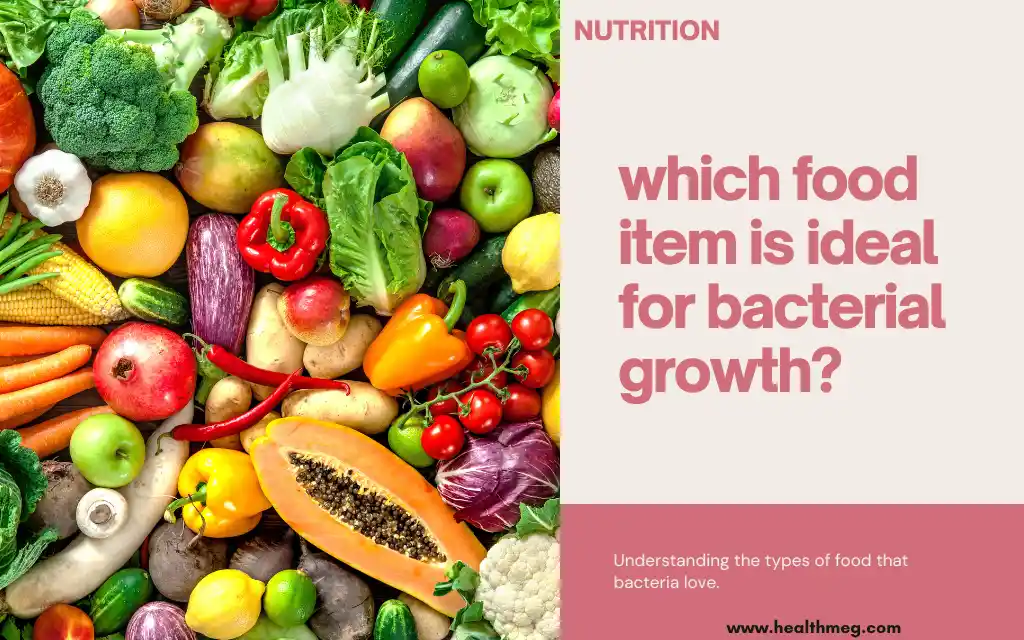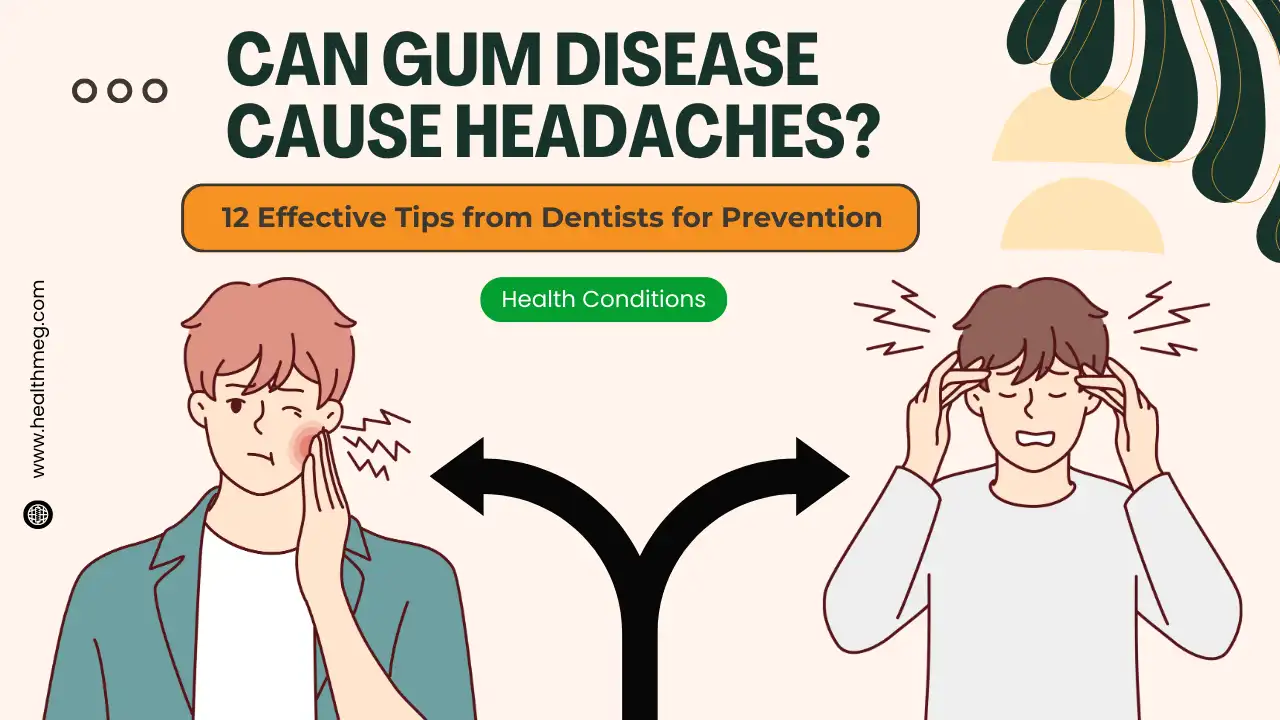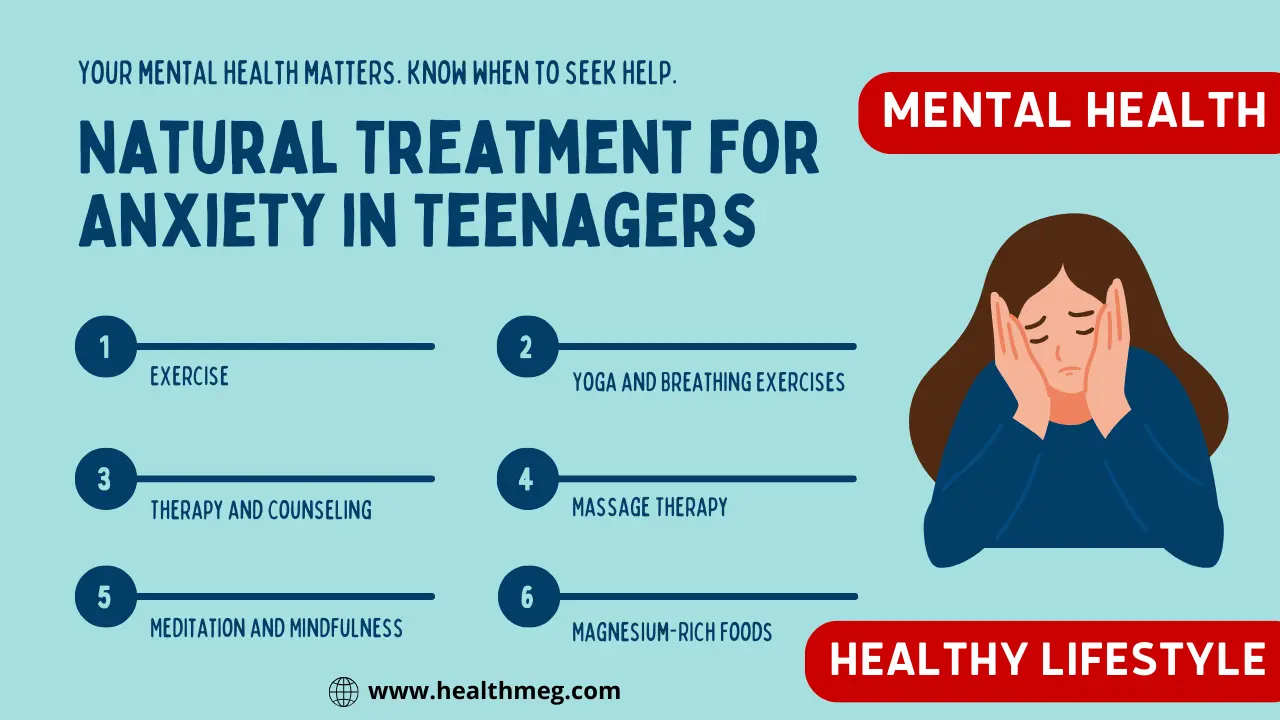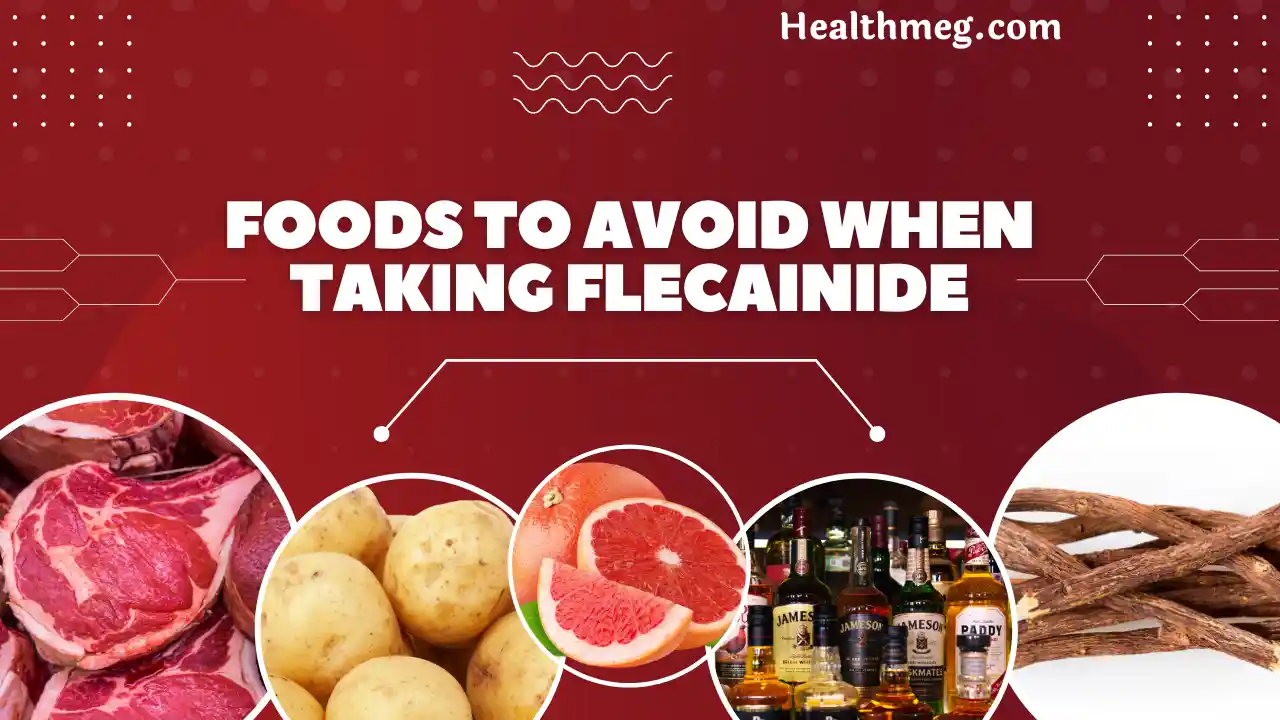Introduction
Bacterial growth in food is a major concern for restaurants, food manufacturers, and consumers alike. Certain foods provide ideal conditions for dangerous pathogens like Salmonella, Listeria, and E. coli to rapidly multiply to dangerous levels that can cause foodborne illness. But what exactly makes some foods more prone to bacterial growth than others?
In this comprehensive guide, we’ll explore the key factors that contribute to bacterial growth in food, and reveal which food item is ideal for bacterial growth based on the latest scientific research. Additionally, we provide research-backed tips to prevent dangerous bacteria in your kitchen. Read on to learn:
- The main factors that allow bacteria to thrive in food
- How time, temperature, pH, water activity, nutrients, and oxygen impact bacterial growth
- Which specific food categories are especially risky due to their intrinsic properties
- Proper food safety principles and practices to inhibit bacterial proliferation
- Helpful resources for further learning about safe food handling
Gaining a thorough understanding of how bacteria behave in different foods will empower you to make informed choices to keep your food safe. Let’s get started!
Do read the People Also Ask (FAQs) about this topic.
Key Takeaways
- Foods with high moisture content are more likely to harbour microorganisms. Bacteria need water to perform metabolic functions, and environments with plenty of moisture offer the right circumstances for their development. Dairy items, fruits, vegetables, raw meats, and dairy products are high-moisture foods.
- Foods rich in nutrients, such as proteins, carbohydrates, and lipids, provide bacteria with the necessary resources for growth. These macronutrient-rich foods may offer the best conditions for bacterial development.
- Foods with a neutral or slightly acidic pH are more favourable for bacterial growth. While some bacteria prefer neutral pH levels, others flourish in situations that are either acidic or alkaline. Bacterial growth is frequently encouraged by foods like milk and meat that have a pH that is close to neutral.
- Temperature plays a significant role in bacterial growth. The typical range for the “Danger Zone” for bacterial growth is 40°F (4°C) and 140°F (60°C). Foods kept in this temperature range for a lengthy amount of time may encourage bacterial growth. This can be avoided with proper cooking and refrigeration.
Understanding Bacterial Infection
Bacterial infections are illnesses caused by the growth of harmful bacteria in the body. Bacteria are microscopic single-celled organisms that can live everywhere, including in and on our bodies.
Every component present in our environment, including the food we eat, is home to microorganisms known as bacteria. While some bacteria are beneficial, others can cause foodborne illnesses (illnesses caused by food).
Why Does Bacterial Growth Matter?
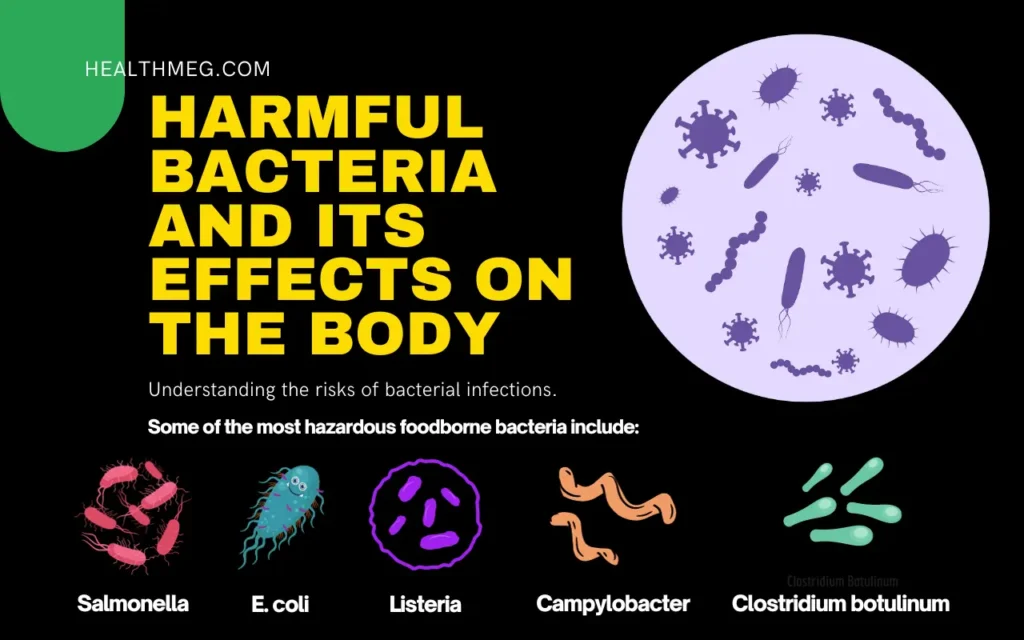
Foodborne pathogens are estimated to cause 48 million illnesses, 128,000 hospitalizations, and 3,000 deaths each year in the United States ([CDC](https://www.cdc.gov/foodborneburden/estimates-overview.html), 2022). While viruses, parasites, toxins, and chemicals can also cause foodborne diseases, bacteria account for most cases.
Some of the most hazardous foodborne bacteria include:
- Salmonella – Causes salmonellosis infection with symptoms like diarrhoea, fever, and abdominal cramps. Poultry, eggs, and produce are common sources.
- E. coli – Can lead to severe illness or kidney failure in cases like the O157:H7 strain. Transmitted through contaminated meat and produce.
- Listeria – Listeriosis has a high fatality rate, especially among pregnant women, newborns, elderly, and immunocompromised. Listeria occurs frequently in deli meats, soft cheeses, and ready-to-eat foods.
- Campylobacter – Leading cause of bacterial diarrhoea worldwide. Poultry is the primary reservoir.
- Clostridium botulinum – Causes potentially fatal botulism poisoning through toxins produced in anaerobic environments like improperly canned goods.
These and other foodborne pathogens can quickly multiply to dangerous levels if conditions are favourable. Understanding which foods and environments promote growth allows for better risk prevention.
Key Factors That Enable Bacterial Growth (Bacterial Proliferation)
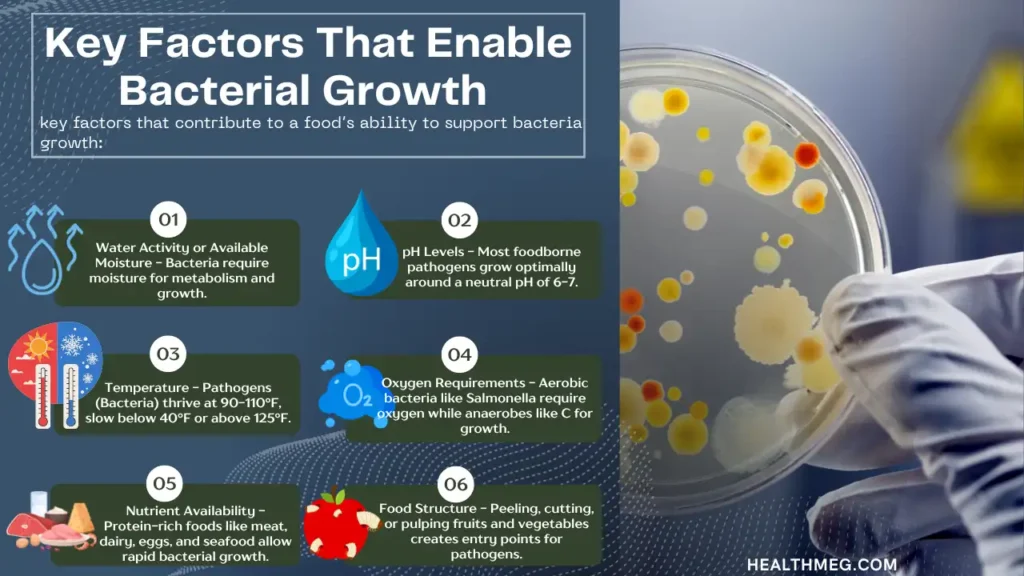
Bacteria are ubiquitous microorganisms that are present virtually everywhere around us. Many are harmless or even beneficial, while some can cause illness. Foodborne pathogenic bacteria become dangerous when allowed to multiply to high numbers in food, increasing the risk of infection when the food is eaten.
While nutrient availability is important, Several key factors that contribute to a food’s ability to support bacteria growth:
- Water Activity or Available Moisture
- pH Levels
- Temperature
- Oxygen Requirements
- Nutrient Availability
- Food Structure
- Other Important Factors
1. Water Activity or Available Moisture
- Bacteria require moisture for metabolism and proliferation (growth) ([FSSAI (https://fssai.gov.in/upload/uploadfiles/files/Guidance_Note_Water_Activity_10_10_2019.pdf)).
- Foods with a high water activity above 0.85 provide more available moisture.
- High-moisture foods include meat, seafood, dairy products, fresh produce, cooked grains/pasta, juices, etc.
- Dried foods like flour, nuts, cereals, and pure spices have lower moisture below 0.7.
2. pH Levels
- Most foodborne pathogens grow optimally around a neutral pH of 6-7 ([FDA](https://www.fda.gov/food/buy-store-serve-safe-food/what-ph)). Acidic environments inhibit bacterial growth.
- Low-acid foods have a pH above 4.6. This includes meat, poultry, seafood, milk, vegetables, etc. These items require canning or pressure treatments to kill bacteria.
- High-acid foods below pH 4.6 like fruits, pickles, sauerkraut, jelly, juice, and tomato products can be safely processed in boiling water.
3. Temperature
- Many pathogens grow fastest at temperatures between 90-110 ̊F while multiplication slows below 40 ̊F or above 125 ̊F ([USDA](https://www.fsis.usda.gov/food-safety/safe-food-handling-and-preparation/food-safety-basics/danger-zone-40f-140f)).
- Holding foods in the danger zone promotes growth. Quick chilling/reheating and avoiding room temperature storage are key.
- Freezing below 0 ̊F stops pathogen growth. Refrigeration at <40 ̊F slows multiplication significantly.
- Cooking foods to their recommended safe internal temperatures kills vegetative cells.
4. Oxygen Requirements
- Aerobic bacteria like Salmonella require oxygen while anaerobes like C. botulinum grow in low oxygen environments ([FDA](https://www.fda.gov/food/buy-store-serve-safe-food/what-you-need-know-about-oxygen-packaging-and-clostridium-botulinum)).
- Vacuum packaging, modified atmosphere packaging, and bottling support anaerobic growth but aerobes cannot proliferate.
- Some bacteria are facultative anaerobes meaning they grow both with or without oxygen.
5. Nutrient Availability
- Protein-rich foods like meat, dairy, eggs, and seafood allow rapid bacterial growth ([CFSAN](https://www.fda.gov/food/consumers/what-you-need-know-about-foodborne-illnesses)).
- Carbohydrates, vitamins, minerals, and more provide fuel for bacterial metabolism and replication.
- Nutritionally deficient foods restrict growth. High sugar, salt, or other additives also inhibit pathogens.
6. Food Structure
- Solid foods with intact surfaces limit bacteria access to nutrients. Grinding, chopping, shredding, etc. provides more entry points.
- Damage to fruits/vegetables through peeling, cutting, or pulping makes it easier for pathogens to establish ([FSSAI](http://old.fssai.gov.in/Portals/0/Pdf/15th_Scientific_Panel_Agenda_Fresh_Fruits_Vegetables.pdf)).
- Some foods have protective outer surfaces like shells/hulls/rinds that guard inner flesh. Removing exposes the food underneath.
7. Other Important Factors
- Food composition – Fat, protein, carbohydrate, water content. Certain substrates impact growth.
- Competitive microflora – Beneficial bacteria can outcompete pathogens for nutrients and space.
- Intrinsic factors – Enzymes, natural chemicals, antimicrobial compounds.
- Extrinsic factors – Packaging, storage conditions, transportation, etc.
Understanding how these several factors interact allows us to predict which types of foods are at the highest risk for dangerous bacterial growth if mishandled. Next, let’s explore major food categories and see why certain foods require strict safety practices.
Categories of Food Prone to Bacterial Growth (Which food item is ideal for bacterial growth?)
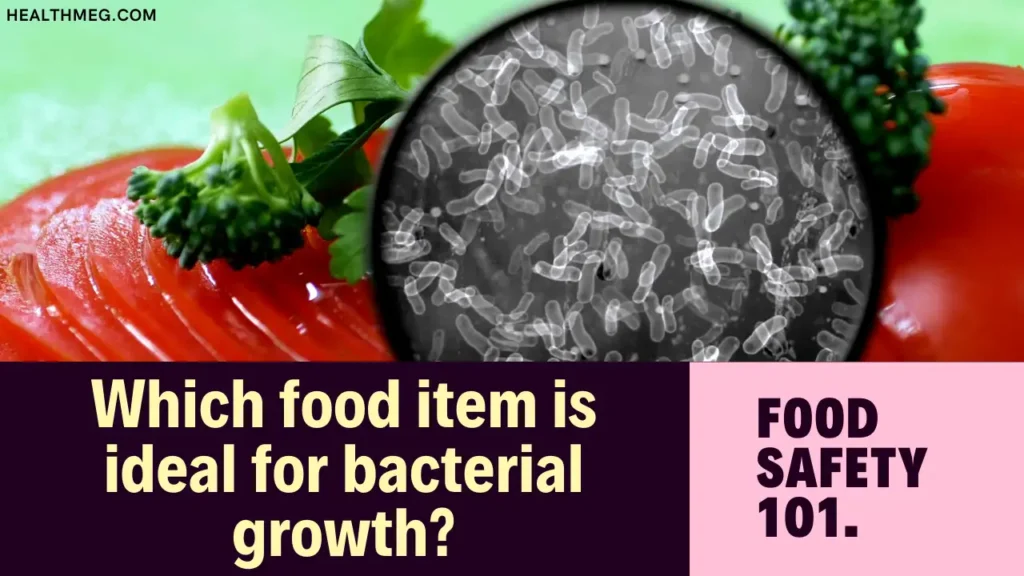
While any food could become contaminated, some provide inherently better conditions for pathogen survival and multiplication. Food items that are ideal for bacterial growth are:
- Meat and Poultry
- Ground Meat and Poultry
- Deli Meats
- Poultry
- Eggs
- Seafood
- Raw Shellfish
- Finfish
- Dairy Products
- Fresh Produce
- Cooked Starches like Rice, Beans, and Pasta
- High Protein, High Moisture Foods
- Canned Foods or Food in Damaged Packaging
- Other High-Risk Foods
- Raw sprouts
- Unpasteurized juices
- Garlic-in-oil
- Refried beans
- Potato salad
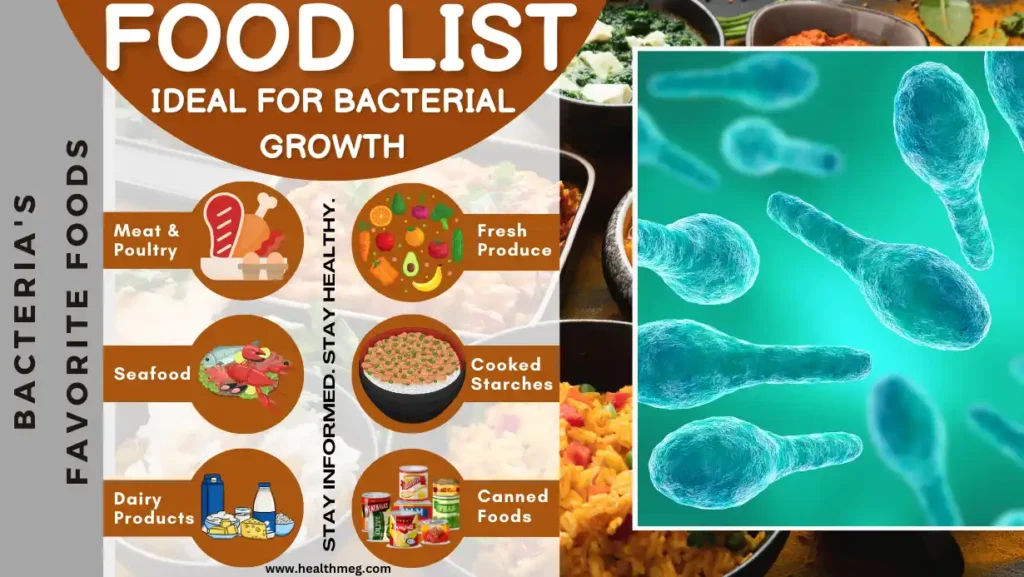
1. Meat and Poultry
Raw animal products are prime bacterial growth media. Raw meats like beef, pork, and lamb have a near-neutral pH of 5.3-6.5, high water activity over 0.99, and are rich in proteins and minerals.
Raw meats are nutritious and moisture-rich, creating an ideal niche for bacteria ([USDA](https://www.fsis.usda.gov/food-safety/safe-food-handling-and-preparation/food-safety-basics/Big-Threat-Small-Bite), [FDA](https://www.fda.gov/animal-veterinary/animal-health-literacy/get-facts-about-food-safety-meat-and-poultry)).
Some important categories of food are as follows:-
# Ground Meat and Poultry
Ground meats present even greater risks due to larger surface area exposure:
- Grinding mixes surface pathogens throughout the product ([CDC](https://www.cdc.gov/foodsafety/communication/ground-beef.html)).
- Common culprits include Escherichia coli O157:H7, Salmonella, Campylobacter, and Listeria.
- Always cook ground meats like hamburgers and turkey to 160 ̊F internal temperature.
# Deli Meats
- Deli meats are commonly implicated in Listeria outbreaks ([CDC](https://www.cdc.gov/listeria/risk-groups/high-risk.html)).
- Slicing equipment can transfer pathogens between products.
- Open displays allow for hands-on contamination at service counters.
- Opt for prepackaged versus prepared-on-site deli meats.
# Poultry
Chicken and turkey present multiple concerns:
- High risk of Salmonella, Campylobacter, and Clostridium perfringens ([USDA](https://www.fsis.usda.gov/food-safety/safe-food-handling-and-preparation/poultry)).
- Raw juices can spread bacteria to surfaces, utensils, ready-to-eat foods, etc.
- Cook poultry to 165 ̊F internal temperature. Avoid washing raw poultry.
# Eggs
Raw or undercooked eggs pose risks:
- Can be contaminated with Salmonella Enteritidis internally ([FDA](https://www.fda.gov/food/buy-store-serve-safe-food/what-you-need-know-about-egg-safety)).
- Cook eggs until yolks and whites are firm. Use pasteurized eggs when recipes call for raw eggs.
- Dishes with raw eggs like homemade mayo, mousse, dressings, etc. are hazardous.
2. Seafood
Fish and shellfish from contaminated waters can cause foodborne disease:
# Raw Shellfish
- Oysters, mussels, clams and more are high-risk ([FDA](https://www.fda.gov/food/people-risk-foodborne-illness/raw-or-undercooked-shellfish)).
- Naturally filter and concentrate bacteria, viruses, and toxins from the water.
- Cooking thoroughly eliminates risks of vibrio, norovirus and more. Avoid raw consumption.
# Finfish
Fish risks include:
- Raw preparations like sushi, sashimi, and ceviche ([FDA](https://www.fda.gov/food/people-risk-foodborne-illness/raw-or-undercooked-fish)).
- Parasites like tapeworm, and roundworm larvae. Freezing or cooking fish first kills parasites.
- Bacterial growth in cooked fish stored at unsafe temperatures.
3. Dairy Products
Unpasteurized dairy products, soft cheeses, and dairy-based desserts are prone to contamination by Listeria, Salmonella, Campylobacter, and E. coli. Raw milk has a neutral pH and high water activity ideal for pathogens. The low pH of cheeses like cheddar or Swiss inhibits bacteria, but soft cheeses have more available moisture. Cream-based desserts are also vulnerable.
Dairy foods present multiple risks:
- Raw, unpasteurized milk may contain Brucella, Salmonella, Listeria, Campylobacter, E. coli O157:H7 ([FDA](https://www.fda.gov/food/buy-store-serve-safe-food/dangers-raw-milk)).
- Soft cheeses made from raw milk frequently cause Listeria outbreaks ([CDC](https://www.cdc.gov/listeria/outbreaks/cheese-10-21/index.html), [CDC](https://www.cdc.gov/listeria/outbreaks/hispanic-soft-cheese-02-21/index.html)).
- Improper pasteurization can allow pathogens to survive ([FDA](https://www.fda.gov/food/buy-store-serve-safe-food/safe-food-handling)).
- Post-processing contamination of cheese, yoghurt, butter, ice cream etc. also occurs.
4. Fresh Produce
Fresh fruits and vegetables can harbour Salmonella, E. coli, Listeria, and other pathogens. Leafy greens, sprouts, and melons are common sources of produce outbreaks due to growing conditions, handling practices, and minimal processing. Shredding and cutting produce exposes nutrients and raises water activity.
Fruits and vegetables generally are low risk, but issues can arise:
- Irrigation or wash waters may contaminate produce ([CFSAN](https://www.fda.gov/food/consumers/how-prevent-cross-contamination)).
- Direct contact with animals or infected workers ([CDC](https://www.cdc.gov/foodsafety/communication/leafy-greens.html)).
- Cutting and peeling breaches protective surfaces ([EFSA](https://www.efsa.europa.eu/en/topics/topic/ready-to-eat-salads)).
- Pathogens then can multiply in damaged tissues and juices.
5. Cooked Starches like Rice, Beans, and Pasta
Cooked starches left at room temperature provide rich nutrients for bacterial growth as they cool to the danger zone. Spore-forming bacteria like Bacillus cereus and Clostridium perfringens thrive on cooked rice, beans, grains, pasta, and starchy vegetables when held improperly. Reheating doesn’t destroy certain toxins.
6. High Protein, High Moisture Foods
Protein-rich salads, lunchmeats, custards, gravies, and dairy or egg-based sauces provide bacteria ample nutrients in a high moisture environment. Listeria risks in deli meats can persist even when vacuum-packed and refrigerated. Strict cold holding is critical for these products.
7. Canned Foods or Food in Damaged Packaging
Canned foods high in protein and moisture can support the rapid growth of Clostridium botulinum if can become damaged and compromise the vacuum seal. Dents, swelling, leaks, or deep rust indicate potential toxin production. Never use canned food from containers showing signs of damage.
8. Other High-Risk Foods
Additional sources of foodborne illness include:
- Raw sprouts – Alfalfa, mung bean, radish, etc. Sprouting environment perfect for Salmonella, E. coli, and Listeria ([FDA](https://www.fda.gov/food/buy-store-serve-safe-food/lesson-1-sprouts-safe-methods-serving)).
- Unpasteurized juices – Unpasteurized apple cider, orange juice, etc harbour pathogens ([FDA](https://www.fda.gov/food/buy-store-serve-safe-food/dangers-unpasteurized-juices)).
- Garlic-in-oil – Bottled/infused garlic or herbs in oil can support C. bot growth without acidity ([FDA](https://www.accessdata.fda.gov/scripts/cdrh/cfdocs/cfcfr/CFRSearch.cfm?fr=101.17)).
- Refried beans – Improper heating allows toxin formation ([CDC](https://wwwnc.cdc.gov/eid/article/5/5/99-0507_article)).
- Potato salad – Potatoes, eggs, and dressing support bacterial growth ([FSIS](https://www.fsis.usda.gov/food-safety/safe-food-handling-and-preparation/poultry/turkey-basics-leftovers-and-food-safety)).
These categories represent the most bacteria-prone foods. However, any food can become hazardous if handled improperly.
Proper handling, storage, and preparation control risks with any food. However, these items warrant extra caution due to the increased potential for pathogens.
How do Bacteria Contaminate Food?
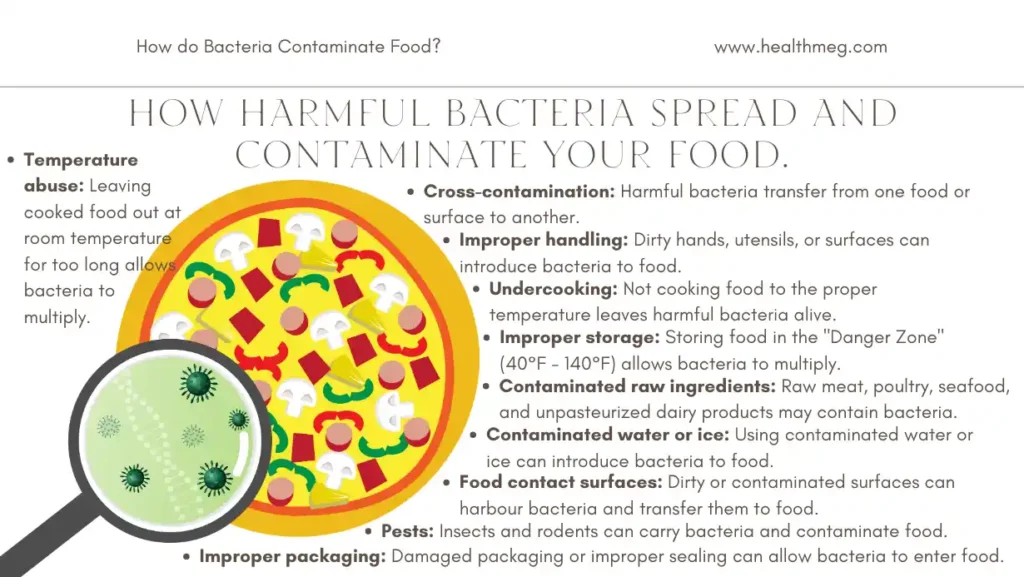
Now that we know which foods can promote growth, it’s also crucial to understand contamination routes:
1. During Production
- Infected food workers
- Unclean equipment/surfaces
- Improper storage temperatures
- Contaminated ingredients
2. During Processing
- Inadequate heating, pasteurization, curing
- Unhygienic practices
- Cross-contamination
3. During Preparation
- Use of contaminated raw ingredients
- Contact with other contaminated foods
- Inadequate cooking temperatures
- Prolonged time in the danger zone
4. After Cooking
- Slow cooling of cooked foods
- Improper hot/cold holding
- Poor personal hygiene
- Unsanitary food contact surfaces
5. At Service
- Infected food workers
- Contact with raw ingredients
- Time/temperature abuse
- Unsafe food sourcing
6. In the Home
- Undercooked foods
- Lapses in handwashing
- Cross-contamination in kitchen/grill
- Inadequate refrigeration
- Prolonged ambient temperature storage
Pathogens can enter at any point and multiply if conditions allow. Robust food safety practices during all steps – production, processing, transport, preparation, storage, and service – are needed to minimize contamination opportunities.
Proper procurement, adherence to established safety plans like Hazard Analysis Critical Control Points (HACCP), plus cold chain management and sanitation safeguard our food supply.
Science-Based Tips to Prevent Foodborne Bacteria (Expert Food Safety Advice to Control Bacteria Growth)
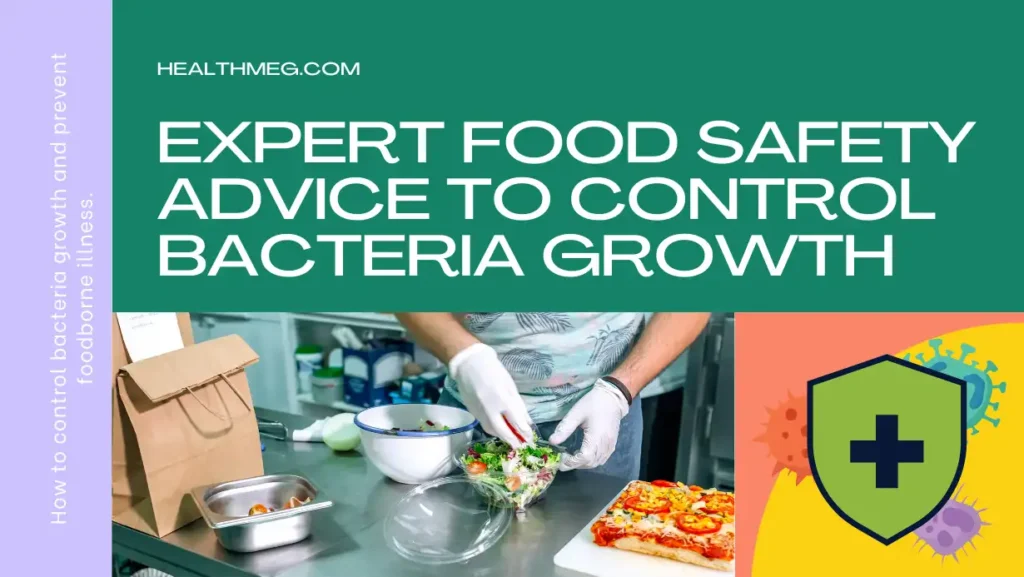
Based on the scientific evidence and foodborne illness data, following food safety best practices at home is vital:
1. Shopping (Source Safely)
- Purchase foods from reputable suppliers with high standards for sanitation and quality control in place.
- Examine food packaging. Avoid cans with damage or swelling.
- Check use-by dates. Do not purchase expired foods.
- Choose pasteurized dairy. Avoid raw milk products.
- Reject bruised, damaged, mouldy produce.
- Place raw meats/poultry in separate bags from other items.
2. Storage (Store Food Properly)
- Refrigerate perishable foods promptly, within 2 hours of shopping or preparing ([FDA](https://www.fda.gov/food/buy-store-serve-safe-food/safe-food-handling)).
- Set refrigerator below 40 ̊F and freezer below 0 ̊F. Use a thermometer to verify.
- Follow the “First-In-First-Out” approach, using the oldest items first. Monitor use-by dates.
- Divide foods into small, shallow containers for fast chilling.
- Keep raw proteins like meat, poultry, seafood, and eggs separated from ready-to-eat foods during storage and prep.
3. Thawing
- Thaw in refrigerator, cold water changed every 30 mins, microwave, or as part of the cooking process ([FSIS](https://www.fsis.usda.gov/food-safety/safe-food-handling-and-preparation/food-safety-basics/big-thaw-safe-defrosting-methods)).
- Avoid thawing at room temperature or other slow methods ideal for bacterial growth.
4. Preparation
- Wash hands before starting and after touching raw animal products ([CDC](https://www.cdc.gov/handwashing/show-me-the-science.html)).
- Use different cutting boards, utensils, and platters between raw and cooked/ready-to-eat items ([FDA](https://www.fda.gov/food/buy-store-serve-safe-food/cutting-boards-and-food-safety)).
- Wash all produce thoroughly under running water before eating/prep.
- Leftovers – 165°FMarinate foods in the refrigerator. Do not reuse marinade.
- Defrost frozen foods in the microwave or fridge, not at room temp.
5. Cooking
- Use a food thermometer to verify safe internal temperatures ([USDA](https://www.fsis.usda.gov/food-safety/safe-food-handling-and-preparation/food-thermometers/how-temperatures-affect-food)):
- Poultry – 165°F
- Ground meats – 160°F
- Pork, beef, fish – 145°F
- Eggs – 160°F
- Leftovers – 165°F
- Bring sauces, soups, and gravies to a full rolling boil.
- Cook and stir foods thoroughly at proper temperature and time combinations to destroy pathogens (vegetative bacteria cells and many toxins) ([FSIS](https://www.fsis.usda.gov/food-safety/safe-food-handling-and-preparation/food-safety-basics/washing-food-does-it-promote-food-safety)).
6. Serving
- Expert Food SaNever leaves perishable foods like egg dishes, cut produce, dairy products, meats, poultry, or fish at room temp over 2 hours (1 hour if above 90°F) ([FDA](https://www.fda.gov/food/buy-store-serve-safe-food/safe-food-handling)).
- Keep hot foods above 140°F and cold foods below 40°F during service.
- Do not reuse platters, utensils, and plates that previously held raw meat/seafood for cooked items unless washed first.
- Use clean tongs, spoons, and forks when handling food. Never re-dip dirty utensils back into food.
7. Leftovers
# Chill Food Quickly
- Prepare smaller batches for quick chilling. ([FSIS](https://www.fsis.usda.gov/food-safety/safe-food-handling-and-preparation/food-safety-basics/leftovers-and-food-safety)).
- Refrigerate within 2 hours, or 1 hour if outdoor temps above 90°F.
- Limit time in the “danger zone” between 41-135°F.
- Avoid slow cooling of large volumes of food.
- If in doubt, throw it out! Discard foods that smell, taste, or appear odd.
- Use ice baths or blast chillers to rapidly cool food.
# Reheat Food Properly
- Use a food thermometer to confirm safe internal temperatures.
- Only reheat foods once, and quickly reheat to 165 ̊F.
- Certain spore-forming pathogens can survive initial cooking and produce toxins when food is slowly reheated.
- Bring sauces, gravies and soups to a full rolling boil when reheating.
- Discard marinades are used on raw proteins.
- If in doubt, throw it out! Discard foods that smell, taste, or appear odd.
8. When Eating Out
- Choose restaurants that visibly uphold food safety standards in kitchen, prep, and service areas.
- Ensure hot foods arrive hot and cold foods cold. Send back items sitting at room temperature.
- Ask if raw or undercooked animal products are used in dishes you order if a concern for your health.
- Send back foods you feel were not cooked thoroughly or that have an “off” smell, taste, or appearance.
9. Practice Good Personal Hygiene
- Wash hands thoroughly before handling food and after touching raw proteins.
- Avoid cross-contaminating foods via unclean hands.
- Do not prepare food when ill with vomiting or diarrhoea.
- Food workers should not work with food for 24 hours after symptoms resolve if diagnosed with norovirus, Salmonella, Shigella, E. coli, or Hepatitis A.
10. Sanitize Surfaces and Equipment
- Clean and sanitize food contact surfaces, and utensils, and prep equipment after each use.
- Use a sanitiser safe for food contact surfaces at the proper concentration.
- Disinfect non-porous surfaces with 1000 ppm bleach solution.
- Replace worn utensils and boards that cannot be properly cleaned.
Following basic food safety principles like these can help significantly reduce the risks of foodborne illness. But remember that certain foods require extra precautions based on their intrinsic risks and properties.
Conclusion
In summary, high protein foods like meat, poultry, seafood, eggs, and dairy inherently present more ideal conditions for bacterial growth due to nutrient availability, water content, and neutral pH. However, any food can become contaminated if handled improperly.
Bacteria multiply fastest between 40-140°F and reach dangerous levels after food sits at room temperature for over 2 hours. Proper refrigeration, avoiding cross-contamination, cooking foods thoroughly, and upholding cleanliness blocks opportunities for pathogens to spread.
Implementing food safety best practices at every step, from purchasing to consumption, reduces your risks. Follow the science-based guidance when shopping, storing, prepping, cooking, and serving food to keep your meals bacteria-free.
People Also Ask (FAQs)
Q) What 3 types of food are most likely to grow bacteria?
A) Types of food that are most likely to grow bacteria are:-
- High-moisture foods: Bacteria thrive in moist environments, making foods like meats, dairy products, fruits, and vegetables more susceptible to bacterial growth.
- Nutrient-rich foods: Bacteria require nutrients for growth, and foods rich in proteins, carbohydrates, and fats provide an ideal breeding ground.
- Foods with a neutral pH: Bacteria prefer a neutral or slightly acidic pH, making foods like milk and meat more favourable for their growth.
Q) What foods are high in bacteria?
A) Foods that are high in bacteria include dairy products, raw meat, and cooked rice. Because of their moisture and nutrient content, these foods are perfect for the growth or proliferation of bacteria. To ensure food safety, careful handling and storage are essential.
Q) What not to eat during bacterial infection?
A) During a bacterial infection, it’s advisable to avoid dairy products, raw or undercooked meat and seafood, and unpasteurized foods. Due to the possibility of dangerous bacteria present, these could make your condition worse and worsen the infection.
Q) What protein kills bacteria?
A) Antimicrobial peptides (AMPs) are proteins that can kill bacterial organisms. These naturally produced proteins interfere with the essential operations of bacteria or damage their cell membranes as part of the body’s defence response, helping to eradicate or kill pathogenic organisms (bacterial organisms).
Additional Food Safety Resources (References)
Expanding your food safety knowledge is the first step toward improved practices. Here are some recommended resources with science-based guidance for optimal food handling and preparation:
- FDA Food Code: Comprehensive food safety standards for restaurants, retailers and institutions. [https://www.fda.gov/food/fda-food-code/food-code-2017](https://www.fda.gov/food/fda-food-code/food-code-2017)
- ServSafe Manager Certification: Nationally recognized food safety training and certification program. [https://www.servsafe.com/ServSafe-Manager](https://www.servsafe.com/ServSafe-Manager)
- USDA FoodKeeper App: Storage advice to maximize food freshness and minimize waste. [https://www.foodsafety.gov/keep-food-safe/foodkeeper-app](https://www.foodsafety.gov/keep-food-safe/foodkeeper-app)
- Fight Bac! Partnership: Food safety education for consumers. [https://www.fightbac.org/](https://www.fightbac.org/)
- NSF International: Food equipment standards and training for commercial kitchens. [https://www.nsf.org/](https://www.nsf.org/)
- State or Local Health Department: Area-specific regulations and food handler training opportunities.
- FDA Bad Bug Book: Microbiology and control of major foodborne pathogens. [https://www.fda.gov/food/foodborne-pathogens/bad-bug-book-second-edition](https://www.fda.gov/food/foodborne-pathogens/bad-bug-book-second-edition)
- CDC Estimates of Foodborne Illness: Burden and trends of major foodborne diseases. [https://www.cdc.gov/foodborneburden/estimates-overview.html](https://www.cdc.gov/foodborneburden/estimates-overview.html)
The more you learn about how bacteria behave, the better equipped you’ll be to make smart food safety decisions.
Share this guide with family, friends, and coworkers to spread food safety awareness. Stay vigilant against foodborne illness by keeping foods out of the danger zone for bacteria growth.
